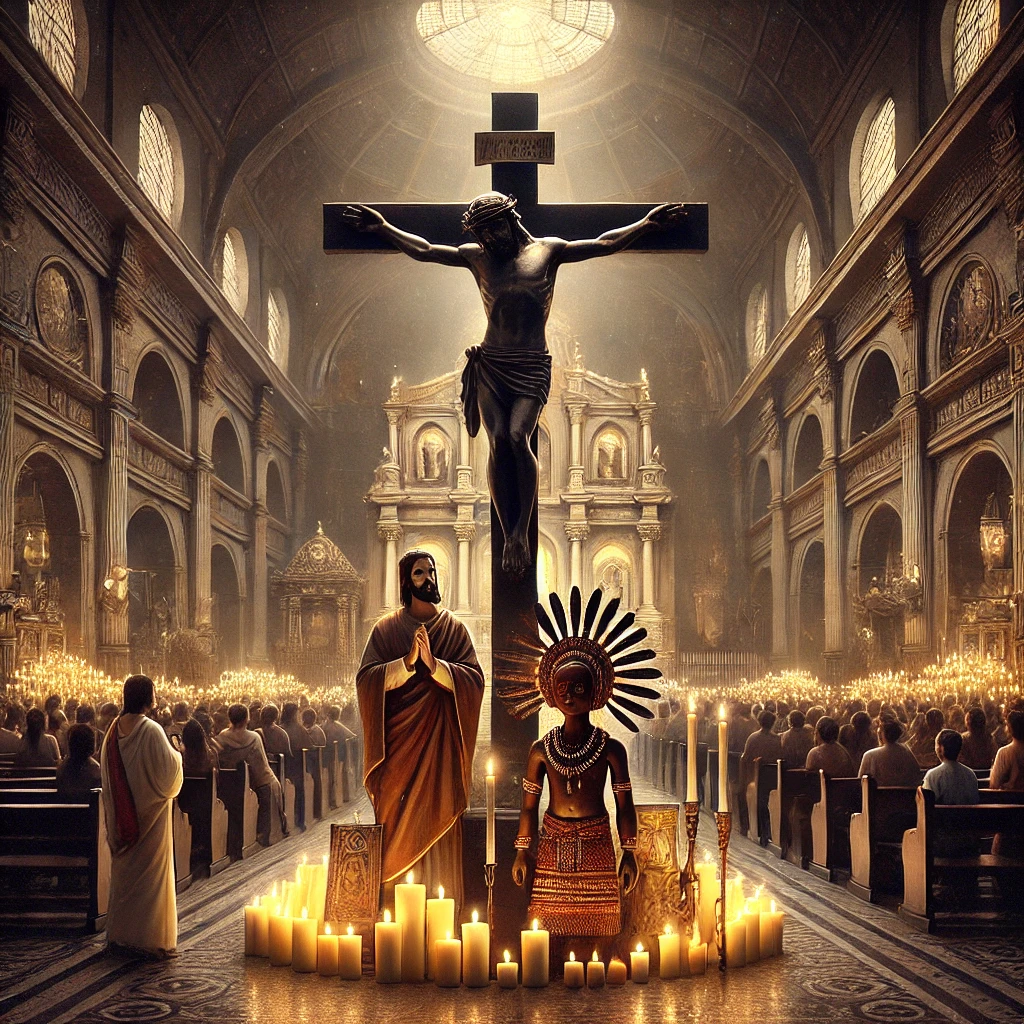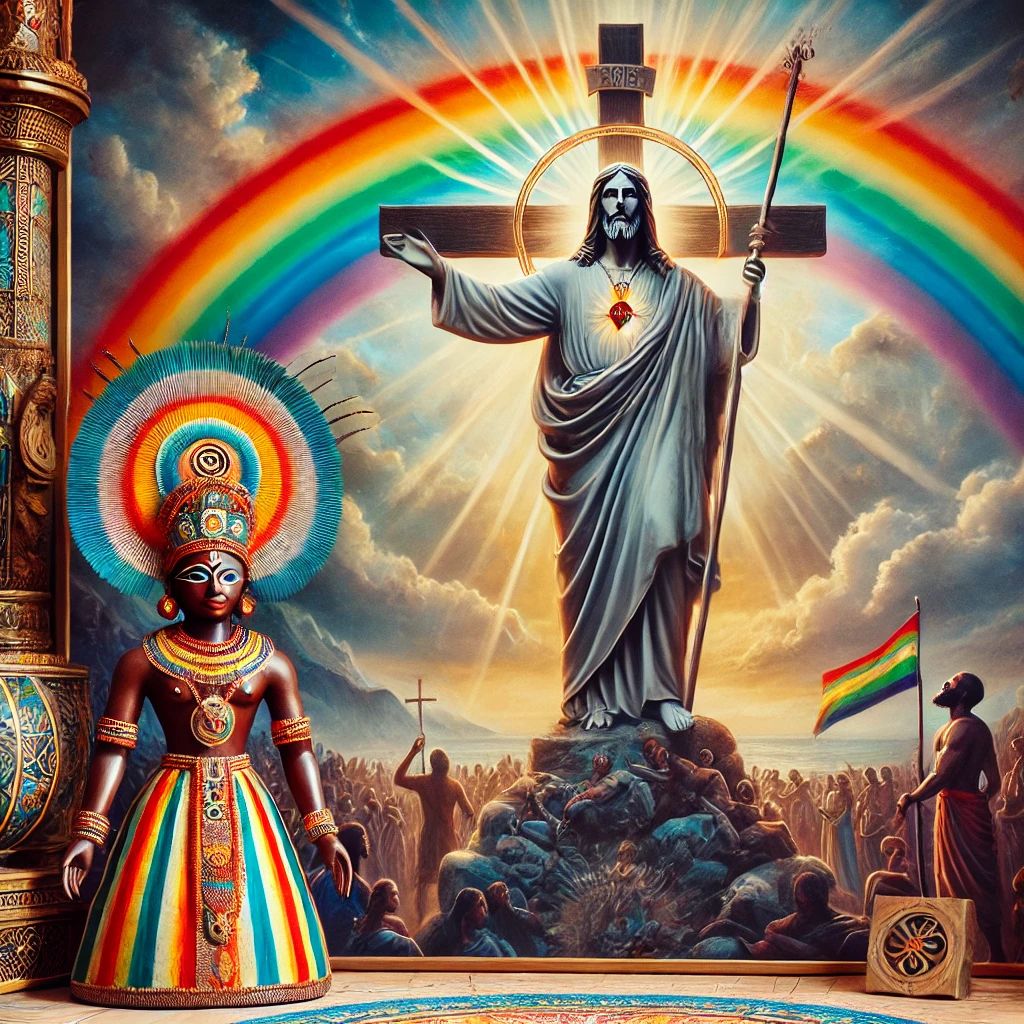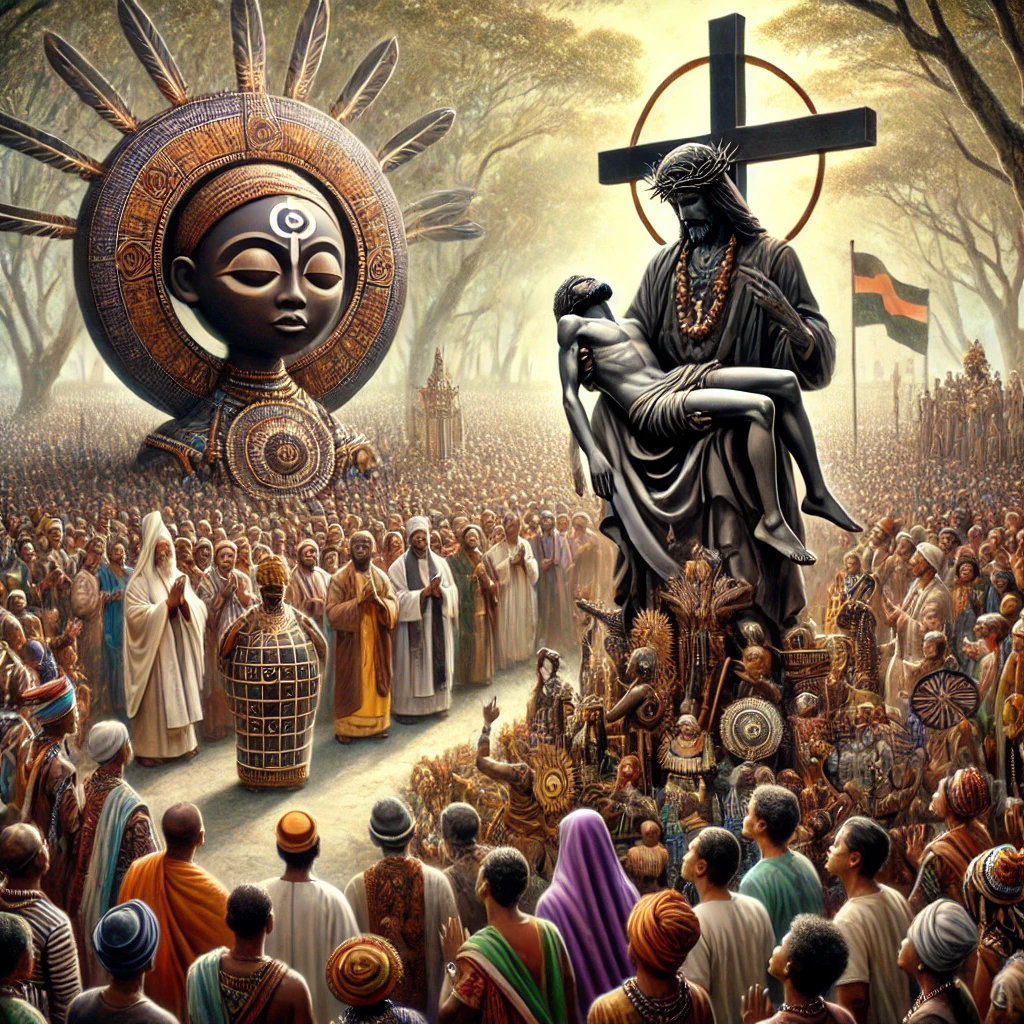The Black Nazarene: A Symbol of Filipino Catholic Devotion
Introduction to the Black Nazarene
The Black Nazarene is a revered religious icon among Filipino Catholics, symbolizing both faith and resilience. Originating from a dark-skinned statue of Jesus Christ carrying the Cross, the Black Nazarene is often associated with the suffering and sacrifice of Christ, deeply resonating with the experiences of the Filipino people. The statue is said to have been created in Mexico in the early 17th century and was brought to the Philippines by a group of Spanish missionaries. It eventually found its home in the Quiapo district of Manila, where it has become an integral part of the Filipino Catholic identity.
Within the context of Catholicism, the Black Nazarene embodies the themes of redemption and penance. Devotees believe that the statue possesses miraculous powers and can grant healing and favors to those who exhibit deep faith. This belief is largely reflective of the broader Catholic doctrine, which recognizes the significance of sacrificial love and the enduring strength found in tribulation. The annual celebration of the Feast of the Black Nazarene draws millions of pilgrims who partake in a procession that is as much a religious observance as it is a communal event, underscoring the cultural fabric The Black Nazarene: A Symbol of Filipino Catholic Devotionof the Philippines.
Culturally, the Black Nazarene transcends mere religious significance and serves as a potent symbol of Filipino identity. It encapsulates the resilience and devotion of the people, particularly evidenced in the grandiose celebrations that showcase unity and faith. Through the years, it has become a rallying point for various social and spiritual issues faced by the community, highlighting the intersection of faith, culture, and social consciousness. Thus, the Black Nazarene stands as a vital figure, setting the stage for the rich tradition and unwavering commitment of Filipinos to their faith.
Historical Background

The Black Nazarene, a revered statue of Jesus Christ carrying the cross, has a rich historical significance that resonates deeply with Filipino Catholic devotion. Its origins can be traced back to 1606 when it was commissioned by a Spanish friar, who sought to create a representation of Christ that embodied humility and suffering. The statue was carved from dark wood and painted to enhance its striking appearance, which eventually led to its iconic name, the Black Nazarene.
Initially, the statue traveled from Mexico to the Philippines aboard a galleon. Upon its arrival, it was enshrined at the San Juan Bautista Church in Quiapo, Manila. This transition marked the beginning of the statue’s journey into the hearts of Filipinos, who soon began to connect with its imagery of Christ’s sacrifice and resilience. The Black Nazarene became a focal point for both the local community and broader Filipino society, inviting countless devotees to engage in acts of piety and reflection.
Today, the Black Nazarene stands not only as a religious symbol but also as a cultural emblem, reflecting the strength and resilience of the Filipino people through their fervent devotion and deep-rooted faith. Its history continues to inspire generations, asserting its place in Filipino spirituality and identity.
The Symbolism of the Black Nazarene
The Black Nazarene is imbued with rich symbolism that resonates deeply with the Filipino Catholic community. The statue’s dark complexion is particularly significant, representing the struggles and hardships faced by many Filipinos throughout history. This portrayal serves as a reminder of the enduring resilience of the people in the face of adversity. The color black is often associated with suffering, but it also symbolizes strength and hope, evoking a sense of solidarity with those who endure trials in life.
A notable feature of the Black Nazarene is its pose, which depicts the figure carrying the cross. This position strongly resonates with the Christian narrative of sacrifice and redemption. It serves as a powerful reminder of Jesus Christ’s suffering and the burdens he carried for humanity. For many devotees, this image symbolizes their own struggles, as they see reflections of their trials in the life of Christ. The act of carrying a cross, whether literal in the context of the annual procession or metaphorical in daily life, emphasizes the importance of perseverance and faith.
The theological implications of the Black Nazarene’s symbolism extend beyond mere representation. The statue embodies themes of compassion, suffering, and hope. It invites the faithful to engage with their spirituality on a personal level, encouraging a connection to the divine that transcends mere ritual. Moreover, the intense devotion displayed during the annual Traslacion—a procession that draws millions—serves to unify the community, fostering a collective sense of purpose and resilience. The Black Nazarene, therefore, is not just a statue but a living symbol of the spiritual journey of the Filipino people, encapsulating their aspirations and ongoing struggle for faith and hope in an often-challenging world.
Devotional Practices and Traditions
The Black Nazarene, a revered figure in Philippine Catholicism, embodies a profound sense of devotion and reverence among its followers. One of the most significant manifestations of this devotion is through various rituals and processions, which serve to unite communities and foster deeper connections to faith. Among these practices, the Traslación stands out as a yearly event that attracts millions of devotees, showcasing an extraordinary expression of communal spirituality.
The Traslación refers to the annual procession that commemorates the transfer of the Black Nazarene from its original location to the Quiapo Church in Manila. This event typically occurs on January 9 and is marked by fervent displays of faith. Devotees, many of whom walk barefoot, believe that participating in this ritual can lead to miraculous healings and blessings. The procession lasts for hours, often involving a chaotic but deeply moving atmosphere, as the faithful struggle to touch or be as close as possible to the revered statue. This collective endeavor encapsulates a sense of solidarity amongst followers, affirming their shared beliefs and experiences.
Aside from the Traslación, other devotional practices include novenas, candle lighting, and offering of flowers. These rituals, often conducted within the confines of homes or local churches, reflect the everyday faith of devotees. One notable tradition is the practice of “pahalik,” where devotees kiss the statue or its relics, which is believed to imbue the person with healing and divine favor. Moreover, the annual feast of the Black Nazarene features various religious activities, such as masses and confessions, further enriching the spiritual experience for attendees.
The Black Nazarene’s significance transcends mere devotion; it acts as a cultural symbol that strengthens community identity and continuity. Through these rich and diverse practices, Filipino Catholics not only express their individual faith but also engage in a shared narrative of devotion that reflects their historical and spiritual journey.
The Feast of the Black Nazarene
The Feast of the Black Nazarene, celebrated annually on January 9, is one of the most significant events in Filipino religious culture. This devotion revolves around the life-sized statue of the Black Nazarene, which depicts Jesus Christ in agony on the cross. Historically, the feast traces its origins back to the arrival of the statue in Manila in 1606, brought by a group of Augustinian Recollects. Over the centuries, the event has evolved from a small local celebration into a massive gathering that attracts millions of devotees, making it a manifestation of deep religious fervor among Filipinos.
Today, the Feast of the Black Nazarene is marked by a series of vibrant and spiritually uplifting activities. The highlight of the feast is the grand procession known as the “Traslación,” where the Black Nazarene statue is transported through the streets of Quiapo, Manila. The procession transforms into a sea of devotees clad in maroon and yellow, who strive to touch or at least get close to the revered statue, believing that such contact offers healing and miracles. Alongside the procession, the atmosphere is charged with prayers, hymns, and expressions of faith, solidifying the communal aspect of this event.
In addition to the Traslación, the feast includes various religious activities such as solemn masses and the sharing of food among devotees, symbolizing unity and community spirit. Participants often engage in acts of penance, including the traditional “pahalik,” where devotees kiss the statue as a sign of respect and devotion. The sense of camaraderie among attendees is palpable, as they unite in their expressions of faith, illustrating the collective yearning for spiritual connection. The complex tapestry of activities and the fervent devotion displayed during the Feast of the Black Nazarene epitomize the enduring nature of Catholic faith in the Philippines.
Impact on Filipino Identity
The Black Nazarene holds profound significance within the Filipino cultural landscape, transcending its role as a religious figure to become a symbol of collective identity and resilience. Central to the annual Traslacion procession, the image represents not only the religious fervor of Filipino Catholics but also a deep-seated commitment to cultural heritage. This connection manifests vividly in various forms of art, music, and literature. Artists frequently explore themes of faith, sacrifice, and spirituality, drawing inspiration from the intense devotion exhibited by thousands during religious festivities.
In music, traditional hymns and contemporary compositions related to the Black Nazarene often highlight the fusion of religious devotion and national sentiment. These musical expressions unite diverse communities, fostering a shared sense of belonging and collective memory. Furthermore, literary works that depict the Black Nazarene frequently delve into the complexities of Filipino identity, articulating struggles against social injustices and political issues affecting the nation. The connection between faith and national identity distinctly illustrates how this revered figure resonates with the aspirations and challenges faced by the Filipino people.
Additionally, the Black Nazarene serves as a vessel for broader social and political discourse. It invites critical reflections on issues such as poverty, inequality, and governance, providing a platform where individual experiences intertwine with the collective consciousness of the nation. Through the lens of this powerful symbol, we witness the intertwining of spirituality and activism, as many Filipinos find strength and purpose in their devotion. Thus, the Black Nazarene not only embodies the essence of Catholic faith but also stands as a testament to the enduring spirit of Filipinos navigating their complex social landscape.
Global Significance and Recognition
The Black Nazarene is not only a central figure in Filipino Catholic devotion but also a symbol of considerable significance on a global scale. Originating from the Philippines, this revered religious icon has transcended borders and attracted the attention of diverse audiences worldwide. The fervent devotion exhibited during the annual feast, particularly the procession that winds through the streets of Quiapo, Manila, is a spectacle that symbolizes resilience and faith among Filipinos. This mass gathering has now sparked interest beyond local devotees, drawing both national and foreign visitors who wish to witness this unique cultural and religious celebration.
Filipino communities residing abroad have played a pivotal role in promoting the Black Nazarene’s legacy and influence. Major cities around the globe, including those in the United States, Canada, and Europe, have established annual processions and masses dedicated to the Black Nazarene. These events serve to uphold the traditions connected to the figure while fostering a sense of community among Filipino expatriates. The practice not only reinforces religious bonds but also strengthens cultural ties, as it allows overseas Filipinos to maintain their heritage and share it with a broader audience.
The global recognition of the Black Nazarene extends to interfaith dialogue and cultural exchange as well. Events honoring the figure feature participation from various faiths, emphasizing the importance of shared values around faith, resilience, and community. The inclusion of diverse perspectives fosters a thoughtful discourse surrounding the intricacies of devotion and cultural identity. This recognition underscores the Black Nazarene’s role as a symbol of unity and faith that resonates with individuals across different cultures and backgrounds.
Challenges and Controversies
The devotion to the Black Nazarene, a deeply ingrained aspect of Filipino Catholic belief, is also accompanied by various challenges and controversies that merit examination. One of the primary concerns revolves around the commercialization of the devotion. Critics argue that the annual procession, notably the Feast of the Black Nazarene on January 9, has become a spectacle that prioritizes monetary gain over genuine faith. This commercialization manifests in the sale of merchandise, food, and other commodities, leading some to question the authenticity of devotion among participants who may seem more interested in the event’s festive atmosphere than its spiritual significance.
Another vital aspect of the discourse pertains to the evolution of worship practices surrounding the Black Nazarene. Over the years, there have been modifications in rituals and observances that some traditionalists view as radical departures from customary practices. For instance, the increased use of social media during religious festivities has provided a platform for devotees, but it has also led to debates regarding the appropriateness of such practices. There are concerns that these changes may dilute the sacredness of the event, transforming it into a modern social gathering rather than a solemn expression of faith.
Additionally, the potential for fanaticism among some devotees has raised eyebrows within the broader community. Instances of extreme behavior during the procession, such as aggressive acts to touch the statue or injuries sustained while trying to gain closer access, have prompted discussions about the line between devout expression and irrationality. While many view these behaviors as passionate displays of faith, detractors caution that they risk misrepresenting the core values of devotion and reverence inherent in the Black Nazarene’s worship.
Through this examination of the challenges and controversies surrounding the Black Nazarene, it becomes evident that while the devotion remains a cornerstone of Filipino Catholicism, ongoing discussions are necessary to navigate its evolving landscape and ensure that the essence of faith is preserved amidst changing practices.
Conclusion: The Everlasting Legacy of the Black Nazarene
The Black Nazarene remains an enduring symbol of Catholic devotion in the Philippines, representing deep faith and resilience among millions of believers. Over the years, this revered icon has transcended mere religious significance, becoming a poignant emblem of hope and strength for countless devotees. The annual celebration of the Traslación, which draws millions to the streets, reflects the profound connection Filipinos have with the Black Nazarene, showcasing their unwavering faith in the face of life’s challenges.
Throughout this exploration, we have highlighted the historical context and cultural significance of the Black Nazarene, as well as the rituals and practices that surround it. The portrayal of the Black Nazarene in various forms—from statues to processions—serves not only as a powerful religious figure but also as a unifying force for the community. This connection to collective identity reinforces the importance of faith in Filipino society, making the Black Nazarene a vital part of both personal and communal spirituality.
To deepen one’s understanding and connection to this revered figure, individuals can participate in local observances and engage with communities that honor the Black Nazarene. Reading literature, attending masses, and sharing in discussions about the icon’s significance can further enrich one’s spiritual journey. Educational endeavors, such as visiting museums that feature religious art or exploring the history of the Black Nazarene, may also enhance appreciation for its legacy. By embracing these practices, devotees can reinforce their faith while also honoring a long-standing tradition rooted in spirituality and resilience.




Leave a Reply